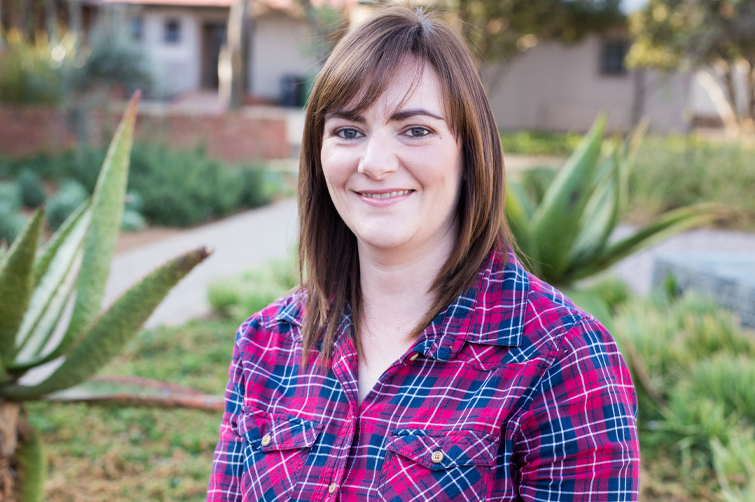Latest News Archive
Please select Category, Year, and then Month to display items
31 December 2019
|
Story Dr Cindé Greyling
|
Photo Anja Aucamp
 Dr Mariana Erasmus, SAENSE Platform Manager, says water remediation is vital for both the ecosystem and industries.
Dr Mariana Erasmus, SAENSE Platform Manager, says water remediation is vital for both the ecosystem and industries.
KovsieInnovation at the UFS supports innovative research outputs in various ways – one of which is to protect the intellectual property and to register patents where viable. This is in line with KovsieInnovation’s broader aim to create third-stream income for the university. Patent registration is a complex process and the UFS is proud to have the needed expertise to properly facilitate such an endeavour.
The SAENSE Platform
South Africa is a water-scarce country, with many water hungry industries (such as agriculture and mining). “Industrial processes often contaminate water with heavy metals, harmful chemicals, radioactive waste, and even organic sludge,” Dr Mariana Erasmus, SAENSE Platform Manager, explains.
Hence, water remediation is vital for both the ecosystem and industries. One of the key functions of the SAENSE Platform is to offer water-remedial solutions for the (bio)remediation of nitrates, heavy metals, and salts, among others. The platform’s activities and services are supported by undergraduate and postgraduate students and researchers, using Technology Innovation Agency (TIA) funding. TIA is a national public entity that serves as key institutional intervention to bridge the innovation chasm between research and development.
From waste to water
Through the joint effort of two mining companies and the UFS/TIA SAENSE Research Platform, a new treatment for mine drainage (MD) has been developed. This patented B-DAS (Barium – Dispersed Alkaline Substrate) technology effectively treats the major contaminants found in acid, alkaline, or neutral mining wastewater. The aim of the B-DAS system is to provide a passive water-treatment solution with minimum waste production; it can also be a potential pre-treatment for reverse osmosis (RO) to lower the requirements of the membranes and therefore potentially reduce the RO cost.
The success of the patent is that it turns unusable water into water that is fit for agricultural purposes at a reduced cost and increased efficiency.
Childhood obesity should be curbed early
2017-03-15

Serious intervention by parents is required to deal
with childhood obesity. Prof Louise van den Berg and
a group of final-year PhD students worked on a study
about the prevalence of obesity in six-year-olds in
South Africa.
Photo: Supplied
If your child is overweight when they start school at the age of six, unless you do something about it at that point, the indications are they are going to be overweight teenagers and obese adults. This is according to University of the Free State’s Prof Louise van den Berg.
Evidence has shown that overweight children and teenagers have a greater risk of developing lifestyle diseases such as type 2 diabetes, hypertension and cardiovascular disease later in life, and dying prematurely.
Obesity is a global pandemic rapidly spreading among adults and children, in developed and developing countries alike.
Dr Van den Berg worked with Keagan Di Ascenzo, Maryke Ferreira, Monja-Marie Kok, Anneke Lauwrens, all PhD students with the Department of Nutrition and Dietetics, to conduct the study. Their research found that children who are overweight by the time they turn six should be screened for weight problems.
Why six-year-olds?
Children who are overweight between the ages of two and five are five times more likely to be overweight when they are 12. There are two periods in a normal life cycle when the body makes new fat cells. The first is in the uterus and the second is around the age of six. The second phase lasts from the age of six to puberty.
The study assessed the prevalence of obesity in six-year-olds as part of a campaign in South Africa to raise awareness of the problem among parents and educators.
A total of 99 children were chosen from seven schools in Mangaung, the capital city of Free State. The schools were chosen from quintile four and five schools, which when measured by their own resources and economic circumstances, are well resourced and serve largely middle-class and wealthy communities.
The children’s weight, height and waist circumference were measured and used to calculate a body mass index score and waist-to-height ratio. Both these figures are good predictors for future lifestyle disease risks such as type 2 diabetes, hypertension and cardiovascular disease. A person with a good waist-to-height ratio can wrap a piece of string equal to their height around their waist at least twice.
When the children had a higher body mass index, they also had an increased waist to height ratio. The study found one in four children from the schools surveyed were overweight when they started primary school.
Nipping the fat in the bud
Although there are many factors that play a role in preventing childhood obesity, parents’ perceptions of their children’s weight play an important role. A recent study found that more than 50% of parents underestimate the weight of their obese children. These parents remain unaware of the risks their children face and are not motivated to take any action.
At least half of the parents whose children are overweight struggle to recognise their children’s weight problems fearing that they will be labelled or stigmatised. By the time they turn six overweight children should be referred to dieticians and nutritionists who are qualified to guide their parents in getting them to eat well and be more physically active at pre-primary and primary school.
The high prevalence of weight problems among six-year-olds found in this study is an urgent call to healthcare professionals to step up and empower parents, educators and children with the necessary skills for healthy dietary practices and adequate physical activity.